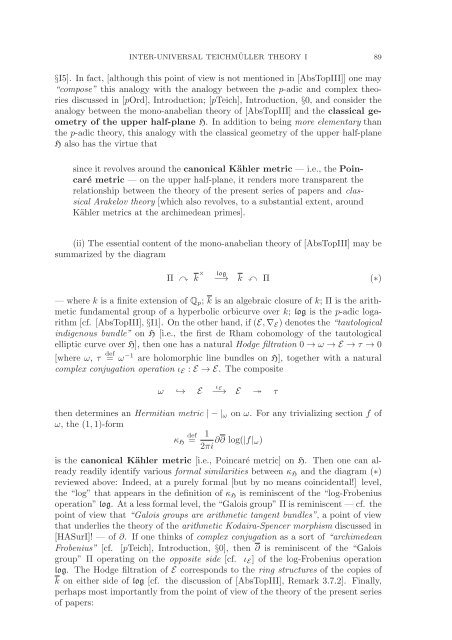Inter-universal Teichmuller Theory I: Construction of Hodge Theaters
Inter-universal Teichmuller Theory I: Construction of Hodge Theaters
Inter-universal Teichmuller Theory I: Construction of Hodge Theaters
Create successful ePaper yourself
Turn your PDF publications into a flip-book with our unique Google optimized e-Paper software.
INTER-UNIVERSAL TEICHMÜLLER THEORY I 89<br />
§I5]. In fact, [although this point <strong>of</strong> view is not mentioned in [AbsTopIII]] one may<br />
“compose” this analogy with the analogy between the p-adic and complex theories<br />
discussed in [pOrd], Introduction; [pTeich], Introduction, §0, and consider the<br />
analogy between the mono-anabelian theory <strong>of</strong> [AbsTopIII] and the classical geometry<br />
<strong>of</strong> the upper half-plane H. In addition to being more elementary than<br />
the p-adic theory, this analogy with the classical geometry <strong>of</strong> the upper half-plane<br />
H also has the virtue that<br />
since it revolves around the canonical Kähler metric — i.e., the Poincaré<br />
metric— on the upper half-plane, it renders more transparent the<br />
relationship between the theory <strong>of</strong> the present series <strong>of</strong> papers and classical<br />
Arakelov theory [which also revolves, to a substantial extent, around<br />
Kähler metrics at the archimedean primes].<br />
(ii) The essential content <strong>of</strong> the mono-anabelian theory <strong>of</strong> [AbsTopIII] may be<br />
summarized by the diagram<br />
Π k ×<br />
log<br />
−→ k Π (∗)<br />
—wherek is a finite extension <strong>of</strong> Q p ; k is an algebraic closure <strong>of</strong> k; Π is the arithmetic<br />
fundamental group <strong>of</strong> a hyperbolic orbicurve over k; log is the p-adic logarithm<br />
[cf. [AbsTopIII], §I1]. On the other hand, if (E, ∇ E ) denotes the “tautological<br />
indigenous bundle” on H [i.e., the first de Rham cohomology <strong>of</strong> the tautological<br />
elliptic curve over H], then one has a natural <strong>Hodge</strong> filtration 0 → ω →E→τ → 0<br />
[where ω, τ def<br />
= ω −1 are holomorphic line bundles on H], together with a natural<br />
complex conjugation operation ι E : E→E. The composite<br />
ω ↩→ E<br />
ι E<br />
−→ E ↠ τ<br />
then determines an Hermitian metric |−| ω on ω. For any trivializing section f <strong>of</strong><br />
ω, the(1, 1)-form<br />
def<br />
κ H = 1<br />
2πi ∂∂ log(|f| ω)<br />
is the canonical Kähler metric [i.e., Poincaré metric] on H. Then one can already<br />
readily identify various formal similarities between κ H and the diagram (∗)<br />
reviewed above: Indeed, at a purely formal [but by no means coincidental!] level,<br />
the “log” that appears in the definition <strong>of</strong> κ H is reminiscent <strong>of</strong> the “log-Frobenius<br />
operation” log. At a less formal level, the “Galois group” Π is reminiscent — cf. the<br />
point <strong>of</strong> view that “Galois groups are arithmetic tangent bundles”, a point <strong>of</strong> view<br />
that underlies the theory <strong>of</strong> the arithmetic Kodaira-Spencer morphism discussed in<br />
[HASurI]! — <strong>of</strong> ∂. If one thinks <strong>of</strong> complex conjugation as a sort <strong>of</strong> “archimedean<br />
Frobenius” [cf. [pTeich], Introduction, §0], then ∂ is reminiscent <strong>of</strong> the “Galois<br />
group” Π operating on the opposite side [cf. ι E ] <strong>of</strong> the log-Frobenius operation<br />
log. The <strong>Hodge</strong> filtration <strong>of</strong> E corresponds to the ring structures <strong>of</strong> the copies <strong>of</strong><br />
k on either side <strong>of</strong> log [cf. the discussion <strong>of</strong> [AbsTopIII], Remark 3.7.2]. Finally,<br />
perhaps most importantly from the point <strong>of</strong> view <strong>of</strong> the theory <strong>of</strong> the present series<br />
<strong>of</strong> papers:
















